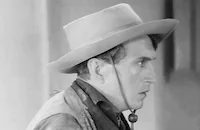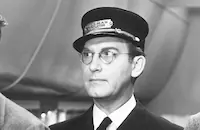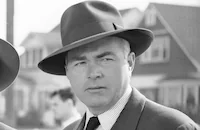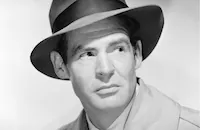The Ghost Breakers

Brief Synopsis
Cast & Crew
George Marshall
Bob Hope
Paulette Goddard
Richard Carlson
Paul Lukas
Willie Best
Film Details
Technical Specs

Synopsis
On the night before he is to leave on a four-week fishing trip, Larry Lawrence, New York's "Walter Winchell" of crime, receives an order from gangster Frenchy Duval to visit him at his hotel. In the hotel hallway, Larry becomes involved in a shooting and, believing that he has killed Ramon Mederos, hides in the steamer trunk owned by guest Mary Carter, who is leaving that night to take possession of an inherited haunted castle on a small island off the coast of Cuba. Upon emerging from the trunk, Larry finds himself aboard a steamer accompanied by his valet, Alex. When Mary receives a death threat, Larry comes to her aid as a "ghost breaker." Despite warnings from Geoff Montgomery, an old acquaintance, and Parada, her Cuban advisor, Mary and Larry remain undaunted in their determination to visit the castle. The night that the steamer docks, they make their way to the island, where they encounter a ghost, a zombie and disembodied voices before coming upon the dying Parada, who tells of his stabbing and a fortune hidden beneath the castle. In the castle basement, they discover a silver mine and Parada's murderer, Montgomery. After Alex dispatches Montgomery, daylight dawns, and they all leave the island in much brighter spirits.

Director

George Marshall
Cast

Bob Hope

Paulette Goddard

Richard Carlson

Paul Lukas

Willie Best
Pedro De Cordoba
Virginia Brissac
Noble Johnson

Anthony Quinn
Tom Dugan

Paul Fix
Lloyd Corrigan
Jack Norton

Emmett Vogan
Grace Hayle
Robert Elliott
James Blaine
Jack Hatfield
David Durand

James Flavin
Leonard Sues
Jack Edwards
Max Wagner
Paul Newlan
Francisco Maran
Blanca Vischer

Douglas Kennedy

Robert Ryan
Kay Stewart
Crew
Walter Deleon
Hans Dreier
Andrew Durkas
Farciot Edouart
Mel Epstein
A. E. Freudeman
Edith Head
Bill Heckler
Ellsworth Hoagland
Arthur Hornblow Jr.
Charles Lang
William Lebaron
Harold Lewis
Richard Olson
Andrea Setaro
Ernst Toch
Robert Usher

Photo Collections
Videos
Movie Clip



Trailer
Film Details
Technical Specs

Articles
The Ghost Breakers
In addition to reuniting Hope and Goddard, Paramount and producer Arthur Hornblow, Jr. brought back cinematographer Charles Lang and art director Hans Dreier to create a similarly eerie atmosphere. To direct, Hornblow enlisted the prolific George Marshall, a veteran of Laurel & Hardy and W. C. Fields comedies. Marshall had also just finished helming the very successful genre-bending Western Destry Rides Again (1939). For their story, the studio knocked the dust off another old spook property. The Ghost Breaker was a play by Paul Dickey and Charles W. Goddard that the studio first filmed in 1914. Cecil B. DeMille directed that version, which starred H. B. Warner and Rita Stanwood. A 1922 version featuring Wallace Reid and Lila Lee followed, with Alfred E. Green directing. By 1940, Paramount not only pluralized the title, they also realized that a more sophisticated audience weren't likely to take yet another film version of this oft-filmed ghost story very seriously so, as with The Cat and the Canary, they mixed generous doses of humor in with the chills.
The film opens as Lawrence Lawrence (Bob Hope, who says "My folks had no imagination"), a New York radio personality who dishes the dirt on crime figures, is preparing to leave town with his valet Alex (Willie Best) on a fishing trip. After a particularly inflammatory broadcast he is called to the hotel of gangster Frenchy Duval (Paul Fix). Alex gives Lawrence a gun for protection, and Larry mistakenly thinks he has used it to kill a man in the hotel corridor. He hides out in the room of heiress Mary Carter (Goddard), escaping the hotel in her steamer trunk. Carter is sailing for Cuba to claim her inheritance of a haunted castle on Black Island. Along for the ride are her Cuban advisor Parada (Paul Lukas), her old friend Geoff (Richard Carlson) and last-minute passengers Lawrence and Alex. In Cuba, they encounter many others; Black Island is crawling with assorted shady characters who want to prevent Carter from taking possession of the castle, not to mention ghosts, a zombie (Noble Johnson), and even Mederos (Anthony Quinn) ¿ the twin brother of the man killed at the hotel back in New York!
The most successful horror comedies are those that present a convincing case for the horror elements (perhaps the best example is Abbott and Costello Meet Frankenstein (1948), in which the classic Universal monsters play it straight, while Bud and Lou cut up around them). Fortunately, The Ghost Breakers spares little expense in presenting a horror atmosphere. The castle sets are huge and convincing, with careful attention paid to lighting and general creepiness. An appropriate sense of menace is established in the initial scenes at Black Island, as well. Though it looks stage-bound, the swamp setting is murky and spooky. The most genuinely horrific element in the picture, though, is the appearance of Noble Johnson as the Zombie. Here director Marshall pulls out the stops in his attempt to induce goosebumps. The Ghost Breakers pre-dates the Val Lewton classic I Walked with a Zombie (1943) by three years, and it is easy to imagine that film's director Jacques Tourneur taking his visual cue from this film. The ambling, staring zombie on view here is every bit as effective as the walking dead of the Lewton film. Of course, even the startling sight of a zombie is fodder for a Hope one-liner:
Geoff: A zombie has no will of his own. You see them sometimes walking around blindly with dead eyes, following orders, not knowing what they do, not caring.
Larry: You mean like Democrats?
The Ghost Breakers was a box-office hit, and following another "Road" picture with Crosby, Paramount again teamed Hope with Paulette Goddard, in Nothing but the Truth (1941). Willie Best also appeared in that film in a major role. Meanwhile, other major studios noted the success Paramount had with horror in comedies. RKO teamed horror stars Boris Karloff, Bela Lugosi, and Peter Lorre in the Kay Kyser vehicle You'll Find Out (1940), and a year after The Ghost Breakers, Universal rushed their resident team, Abbott and Costello, into their first comedy chiller, Hold That Ghost (1941). (Richard Carlson also shows up in that film as one of the straight juvenile leads). Even poverty row studios like Monogram Pictures got into the act with their release of Spooks Run Wild (1941) starring the Bowery Boys and Bela Lugosi.
The horror comedy sub-genre proved to be durable through the years. George Marshall remade his own The Ghost Breakers in 1953 as Scared Stiff, with Dean Martin and Jerry Lewis updating the Hope and Best roles, and with Lizabeth Scott as the heiress. Bob Hope makes a cameo appearance in the film alongside his "Road" picture cohort Bing Crosby.
Producer: Arthur Hornblow, Jr.
Director: George Marshall
Screenplay: Walter DeLeon, based on a play by Paul Dickey, Charles W. Goddard
Cinematography: Charles Lang
Film Editing: Ellsworth Hoagland
Music: Ernst Toch
Art Direction: Hans Dreier, Robert Usher
Costume Design: Edith Head
Cast: Bob Hope (Larry Lawrence), Paulette Goddard (Mary Carter), Richard Carlson (Geoff Montgomery), Paul Lukas (Parada), Willie Best (Alex), Pedro de Cordoba (Havez), Virginia Brissac (Mother Zombie), Noble Johnson (Zombie), Anthony Quinn (Ramon and Francisco Mederos).
BW-85m.
by John M. Miller

The Ghost Breakers
Bob Hope: Thanks for the Memories - THE CAT AND THE CANARY Among the 6 Films Featured in BOB HOPE: THANKS FOR THE MEMORY
The heart of the set belongs to three films Hope made with Paulette Goddard. The young beauty starred opposite Charles Chaplin (whom she secretly married) in Modern Times and famously was a front-runner for the role of Scarlett O'Hara in Gone With the Wind, but it was The Women that showed off her talents as a sly comic actress with a sassy edge, and she became a leading lady in her own right opposite Hope in their version of the oft-filmed haunted house chestnut The Cat and the Canary (1939). Originally filmed in 1927 by Paul Leni (in a version that has yet to be topped), it's a familiar story if only for the all the clichés that it spoofs. The family of the deceased gather in a spooky old mansion (here located in the middle of a bayou swamp) of an eccentric millionaire for the reading of the will and must spend the night in the place to meet the terms of the will. Goddard is the bubbly heroine who is named sole beneficiary (and thus a target for the relative next in line), a spooky servant goes around predicting things like "One will die tonight" and there's an escaped patient from the nearby asylum (in the middle of this swamp?) running around, but never fear. The family's resident celebrity Wally (Hope) is on hand to kid the spirits away. "Don't big old empty houses scare you?" asks one relative (Nydia Westman doing a Zasu Pitts kind of goofy comic relief). "No me," quips Hope, "I've played vaudeville." It's hokey stuff with hidden doors and secret passages and a hidden treasure, which director Elliot Nugent stages with all the style and tension of a sitcom. But Hope and Goddard have marvelous chemistry and Hope is completely amiable, using wisecracks to cover up his discomfort and fear. "I always joke when I'm scared," he confesses to heroine Goddard. "I kind of kid myself into being brave." Hope's delivery makes this less a laugh line than a confession and a promise he's got integrity and the courage to both reveal his vulnerabilities and overcome them. Goddard, meanwhile, is a spunky beauty with crack timing, a born comedienne too often called upon to play the straight man and provide the sex appeal. She does both admirably here and, when the film became a hit, was rewarded with a return engagement with Hope.
The Ghost Breakers (1940) is pretty much a rehash of the same formula, this time with the haunted mansion relocated to Cuba. While Goddard is repeatedly warned away from the place by the suspicious executor of the will, radio celebrity and gossip monger Hope is on the run from New York gangsters. Like Cat, it's based on a stage play that spoofs haunted house stories and ghost story conventions, this one tossing in a zombie (Noble Johnson, doing the traditional Caribbean-style catatonic sleepwalker of a zombie), an animated suit of armor and more hidden rooms and passages. It's even less convincing than Cat but director George Marshall makes an effort to construct the proper atmosphere around these city folk on a haunted safari in voodooland. Both films manage to repeatedly get Goddard down to slips and negligees before the half hour mark and The Ghost Breakers goes one better by putting her in a swimsuit (logical attire for midnight to a spooky island) and a flimsy dress which gets torn off in a monster chase. A very young Anthony Quinn appears in two roles (a New York gangster and his twin brother!) and Richard Carlson co-stars.
Nothing But the Truth (1941) spins another gimmick-Hope is stock broker who bets $10,000 that he can tell the truth for 24 hours-into a familiar web of misunderstandings, mistaken identities and romantic antics. It plays as a more sardonic No, No Nanette with an earnest Hope at the center of the bet and a trio of conniving, lying, borderline criminal business associates (Edward Arnold, Leif Erickson and Glenn Anders) springing every dirty trick in the book on him in a string of public humiliations and private ruses. Goddard has much more fun in this one as a dizzy heiress who rattles a blue streak while falling for the hapless Hope, who can't tell anyone about the bet. It's pure stage farce, all contrivance and coincidence, blandly directed by Elliot Nugent, who just seems to let things happen as the camera rolls. Luckily there's plenty going on as the characters go sneaking around on a private houseboat, slipping in and out of bedrooms and dressing gowns while Hope wraps himself in a flouncy nightgown to escape his rivals. Not only does Hope get the girl like a real leading man, it's the rare film where Hope is the most honest man on screen. Edward Arnold, who played his share of big screen fat cats, embraces the cynical side of the persona as he tries to sell worthless stock to his customers (which doesn't seem quite as funny in light of recent real-life financial shenanigans) and Glenn Anders is almost too sleazy for the film (you may recognize him as the boozy George Grizby from The Lady From Shanghai). It's fascinating how the film manages to strike a happy ending while letting its scheming supporting cast get away with stock fraud and infidelity, winking at the audience the whole time as if we're complicit in the whole sordid business.
The four films feature Bob Hope in a role we're not used to seeing: a light romantic lead with a quick wit. His wisecracks cover up nervousness and fear but are harmless and self-effacing. Where he schemed for a kiss from the leading lady in the "Road" films, he's a genuinely nice guy here. And Goddard makes for a spunky leading lady, holding her own against opposite Hope and, in Nothing But the Truth, showing her own skills as an underrated comedienne. Both are better than their material. They also include the worst stereotypes available to African American performers, with Eddie 'Rochester' Anderson as a comic janitor in Thanks for the Memory and Willie Best as Hope's manservant, a quivering, drawling caricature who gets called "boy" by most everyone except Hope and made the butt of countless jokes (not all of them offensive), in The Ghost Breakers and Nothing But the Truth. Best establishes a natural rapport with Hope while swapping wisecracks (and often getting the better of Hope), but it's a demeaning stereotype.
The biggest disappointment with the set is its haphazard approach to Hope's career. After a quartet of films that captures Hope in his first leading roles, it's filled out with two forties films that not only feel like they've been plucked from the catalogue at random, but are already available DVD. Road to Morocco (1942) is the second of the "Road" movies that Hope made with Bing Crosby and Dorothy Lamour and has previously been released both individually and in an earlier set of "Road" comedies. The Paleface (1948) is a very funny cowboy spoof with tenderfoot Easterner Hope as a would-be "painless" dentist who gets lassoed into marrying shapely outlaw Jane Russell. While The Ghost Breakers has also been previously available, it makes a good match with the two other Hope-Goddard pairings, but these's no real purpose to these films, not with so many other films-Hope's feature debut in The Big Broadcast of 1938, for instance, or his Dorothy Lamour pairings-that could have been included. (While The Cat and the Canary was briefly available in a public domain edition of dubious legitimacy and quality, this is the first studio release of the film.)
The six films are collected in a three-disc digipak that also includes featurettes celebrating Hope's decades-long work with the USO. It includes a pair of mini-documentaries-"Bob Hope and the Road to Success" and "Entertaining the Troops" (featuring exclusive footage of Hope's USO tours)-and the archival shorts "Command Performance 1944" and "Command Performance 1944" (which are newsreel-style recordings of the Hope-hosted radio show produced by the Army-Navy Screen Magazine) and the all-star WWII short Hollywood Victory Caravan. They spotlight yet another side of Hope, the public comedian and tireless entertainer who gave up so much time not just to entertain the troops but to take charge of the USO program and bring other Hollywood celebrities and entertainers into the fold. They make a worthy companion to these films.
For more information about Bob Hope: Thanks for the Memories, visit Universal Home Entertainment. To order Bob Hope: Thanks for the Memories, go to TCM Shopping.
by Sean Axmaker
Bob Hope: Thanks for the Memories - THE CAT AND THE CANARY Among the 6 Films Featured in BOB HOPE: THANKS FOR THE MEMORY
Quotes
A zombie has no will of his own. You see them sometimes walking around blindly with dead eyes, following orders, not knowing what they do, not caring.- Geoff Montgomery
You mean like Democrats.- Larry Lawrance
The girls call me Pilgrim, because every time I dance with one I make a little progress.- Larry Lawrance
Pardon me, am I protruding?- Larry Lawrance
Are you the one advising Miss Carter to sell the castle?- Parada
No, my advice is keep the castle and sell the ghosts.- Larry Lawrance
I myself have heard of only one ghost: the spirit of Don Santiago.- Parada
Tell me, does he appear nightly or just Sundays and Holidays?- Larry Lawrance
Trivia
Notes
According to news items in Hollywood Reporter, Wilkie Mahoney was to have worked on the script, but his participation in the final film has not been confirmed. The film was partially shot on location in Havana, Cuba. Paramount publicity materials contained in the Production Files at the AMPAS Library note that the film introduced the "Sonovox," a machine invented by Gilbert Wright that blended music and the sound of the human voice. The device was used for the disembodied voices in the film. This picture marked Robert Ryan's screen debut. Cinematographer Charles Lang, art director Hans Dreier and stars Bob Hope and Paulette Goddard also worked together in Paramount's 1939 film The Cat and the Canary. Paramount first filmed the Paul Dickey-Charles W. Goddard play in 1914, starring H. B. Warner and Rita Stanwood and directed by Cecil B. DeMille (see AFI Catalog of Feature Films, 1911-20; F1.1541); and in 1922, starring Wallace Reid and Lila Lee and directed by Alfred E. Green (see AFI Catalog of Feature Films 1911-20; F2.2060). Scared Stiff, a 1953 Paramount film starring Dean Martin and Jerry Lewis and directed by George Marshall was also based on the Dickey-Goddard play.

Miscellaneous Notes
Released in United States 1940
Released in United States on Video May 19, 1993
Released in United States 1940
Released in United States on Video May 19, 1993














